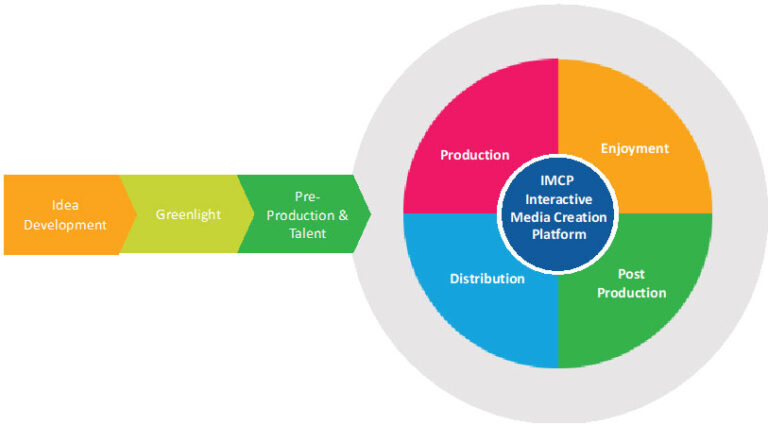Story Telling Future: Improvement & Innovation
Animation, live action, scripted TV, reality programs, music, and other content creation efforts all center on traditional development, pre-production, production, post-production and distribution activities. Enjoyment, and monetization occur at the end of the process. Over many decades major innovation came in terms of color, sound, cameras, and digitalization. The recent pandemic has accelerated workflow improvement in the areas of cloud compute, storage, and production teams working at home and across the world.
But there is more to come on both the innovation and improvement fronts. Improvement will continue to come related to industry anthologies, platform adoption, security advances, cost effective data storage, remote compute, file movement, content transmission, and other necessary creation anywhere cornerstones. But more importantly is how will technology innovation change the way stories and music are created.
It’s not enough to simply take old production processes and place them in the cloud.
That is just improvement.
With all the digital innovation technology capabilities at our fingertips we must follow
Steve Jobs mandate: “Think Different”
Creative Process & Improvement
Improvement – Make something that already exists better
Let’s take a look at storytelling as part of the overall media creation and consumption process. Songwriters have an idea, often they combine music and words to turn this idea into a story or convey a message and the listener feels an emotion and likes or dislikes. Typically, a movie, tv show, or video comes from an idea that is greenlit, and then teams of creators and talent are assembled, and the final product is created and distributed to the viewer and fan.
Very much a creative process where there is a starting point to the process that comes to an end before consumption, revenue, and enjoyment begins.

This traditional process allows for little or no interaction from the creators to the consumer until the magical distribution barrier is reached.
Our industry has been focused on taking the age-old creation workflow process and adding technology for the most part to improve existing processes, BUT NOT INNOVATING the underlying story telling future in creative process.
Color was innovative
Sound was innovative
Both of these capabilities were new and had never been done before
Today’s improvement in our creative industry deals with some of the following: what cloud provider or providers should the industry use, what editing toolset(s) are best, what VDI technology is the best to reduce latency, how do we implement better security, how can files be compressed and moved around the globe, how much security is enough, how can AI be added to monitor the process, how can production costs decrease?
Story telling future Creative Process & Innovation
Innovation – Make something new
How we can use technology to drive innovation, not just improvement?
Let suppose we want to include the viewer/consumer into the creative process and move media enjoyment from the end of the process to be part of the process. Let’s move enjoyment from a sort of passive experience to an interactive creation experience. Along the way we can make storytelling not a one size fits all but more of a tailored viewer experience. (Also create new revenue streams.)
Didn’t like the way Game of Thrones ended?
Don’t worry you can make your own ending or endings!
What would an innovative interactive workflow look like? Maybe we need an Interactive Media Creation Platform, IMCP. (We have to have a three- or four-letter acronym… it’s part of the technology business)

Here is how it would work. First a basic story is conceived. Take for instance a western story set in a galaxy far far away. The storyline is established production and talent teams are assembled and product begins. Consumers can subscribe to the “dailies” via the IMCP, feedback can be discussed in Facebook/Zoom type chat rooms around the world, charactors and scenes could be created or changed in minutes based upon CGI technology, alternative storylines could be conceived, new live action scenes could be shot the next day, the direction and production staff could take this input into consideration and proceed with the original storyline or move the direction of the content to new horizons based upon the interaction. New content could also be localized based upon global input.
Another way the IMCP could be used is at the end of the creation process. All of the artifacts and simits of the production that end up on the virtual cutting room floor could be placed within the editing section of the IMCP and allow the consumer to make their own movies, or content. The user and fan community could create a new partial movie, short Quibi type content, or full-length movie based upon the original extras, CGI created video, and then publish it within part of the IMCP for friends and the public at large. Fees could be charged for this engagement process, and also to view the new content. Revenue could go back to the original content rights owners.
All of this interaction would be based upon technology and tools we have at our fingertips such as: social media interactive sites, group collaboration room technology, cloud-based content editing and publishing tools, and common device, mouse, swiping, and typing skills.
So, the challenge has been thrown down for innovation over improvement. Who will join this quest?
Story telling Future – Innovation
~ 1910’s – first color film
October 6, 1927 – first feature film with sound
July 4, 2022 first movie created using IMCP technology
IMCP… coming soon to a desktop, tablet, or phone near you
Jeff Caldwell is the Vice President of Digital Integration and Cloud Partners with ATMECS. Jeff is well known in the media and entertainment industry, and the technology realm in general, as a business professional with an innovative vision who also has the expertise to make the vision a reality. Currently Jeff is focused on helping organizations achieve five key digital business goals: enterprise efficiency, advanced industry analytics, customer and social engagement, business acceleration and digital industry innovation. Obtaining these digital goals help to drive digitally based revenue.



